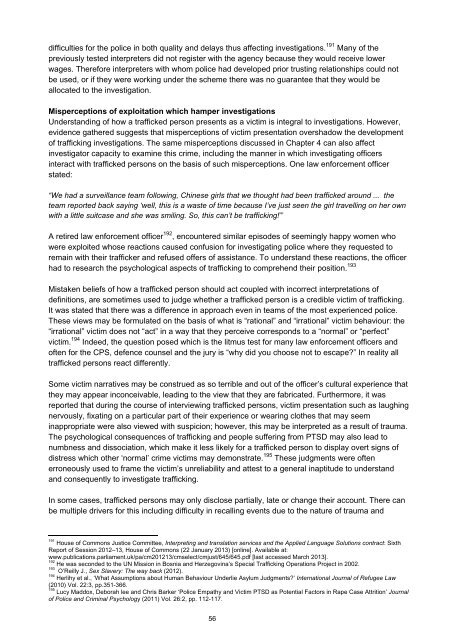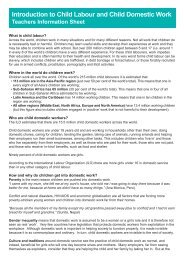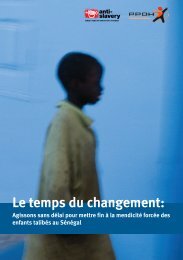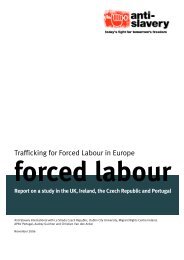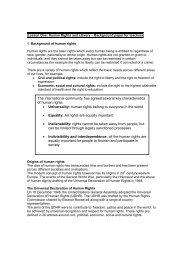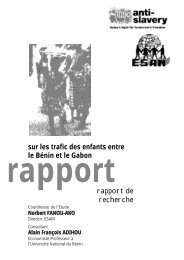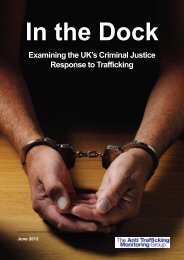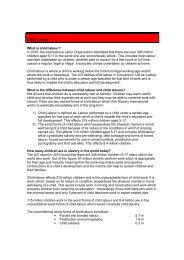difficulties for <strong>the</strong> police in both quality and delays thus affecting investigations. 191 Many of <strong>the</strong>previously tested interpreters did not register with <strong>the</strong> agency because <strong>the</strong>y would receive lowerwages. Therefore interpreters with whom police had developed prior trusting relationships could notbe used, or if <strong>the</strong>y were working under <strong>the</strong> scheme <strong>the</strong>re was no guarantee that <strong>the</strong>y would beallocated to <strong>the</strong> investigation.Misperceptions of exploitation which hamper investigationsUnderstanding of how a trafficked person presents as a victim is integral to investigations. However,evidence ga<strong>the</strong>red suggests that misperceptions of victim presentation overshadow <strong>the</strong> developmentof trafficking investigations. The same misperceptions discussed in Chapter 4 can also affectinvestigator capacity to examine this crime, including <strong>the</strong> manner in which investigating officersinteract with trafficked persons on <strong>the</strong> basis of such misperceptions. One law enforcement officerstated:“We had a surveillance team following, Chinese girls that we thought had been trafficked around ... <strong>the</strong>team reported back saying ‘well, this is a waste of time because I’ve just seen <strong>the</strong> girl travelling on her ownwith a little suitcase and she was smiling. So, this can’t be trafficking!’”A retired law enforcement officer 192 , encountered similar episodes of seemingly happy women whowere exploited whose reactions caused confusion for investigating police where <strong>the</strong>y requested toremain with <strong>the</strong>ir trafficker and refused offers of assistance. To understand <strong>the</strong>se reactions, <strong>the</strong> officerhad to research <strong>the</strong> psychological aspects of trafficking to comprehend <strong>the</strong>ir position. 193Mistaken beliefs of how a trafficked person should act coupled with incorrect interpretations ofdefinitions, are sometimes used to judge whe<strong>the</strong>r a trafficked person is a credible victim of trafficking.It was stated that <strong>the</strong>re was a difference in approach even in teams of <strong>the</strong> most experienced police.These views may be formulated on <strong>the</strong> basis of what is “rational” and “irrational” victim behaviour: <strong>the</strong>“irrational” victim does not “act” in a way that <strong>the</strong>y perceive corresponds to a “normal” or “perfect”victim. 194 <strong>In</strong>deed, <strong>the</strong> question posed which is <strong>the</strong> litmus test for many law enforcement officers andoften for <strong>the</strong> CPS, defence counsel and <strong>the</strong> jury is “why did you choose not to escape?” <strong>In</strong> reality alltrafficked persons react differently.Some victim narratives may be construed as so terrible and out of <strong>the</strong> officer’s cultural experience that<strong>the</strong>y may appear inconceivable, leading to <strong>the</strong> view that <strong>the</strong>y are fabricated. Fur<strong>the</strong>rmore, it wasreported that during <strong>the</strong> course of interviewing trafficked persons, victim presentation such as laughingnervously, fixating on a particular part of <strong>the</strong>ir experience or wearing clo<strong>the</strong>s that may seeminappropriate were also viewed with suspicion; however, this may be interpreted as a result of trauma.The psychological consequences of trafficking and people suffering from PTSD may also lead tonumbness and dissociation, which make it less likely for a trafficked person to display overt signs ofdistress which o<strong>the</strong>r ‘normal’ crime victims may demonstrate. 195 These judgments were oftenerroneously used to frame <strong>the</strong> victim’s unreliability and attest to a general inaptitude to understandand consequently to investigate trafficking.<strong>In</strong> some cases, trafficked persons may only disclose partially, late or change <strong>the</strong>ir account. There canbe multiple drivers for this including difficulty in recalling events due to <strong>the</strong> nature of trauma and191House of Commons Justice Committee, <strong>In</strong>terpreting and translation services and <strong>the</strong> Applied Language Solutions contract: SixthReport of Session 2012–13, House of Commons (22 January 2013) [online]. Available at:www.publications.parliament.uk/pa/cm201213/cmselect/cmjust/645/645.pdf [last accessed March 2013].192He was seconded to <strong>the</strong> UN Mission in Bosnia and Herzegovina’s Special Trafficking Operations Project in 2002.193O’Reilly J., Sex Slavery: The way back (2012).194Herlihy et al., ‘What Assumptions about Human Behaviour Underlie Asylum Judgments?’ <strong>In</strong>ternational Journal of Refugee Law(2010) Vol. 22:3, pp.351-366.195Lucy Maddox, Deborah lee and Chris Barker ‘Police Empathy and Victim PTSD as Potential Factors in Rape Case Attrition’ Journalof Police and Criminal Psychology (2011) Vol. 26:2, pp. 112-117.56
PTSD. 196 A Consultant Psychiatrist also stated that <strong>the</strong>y may also “wish to protect <strong>the</strong> perpetrator or toprotect <strong>the</strong>mselves, but it can also reflect victims' psychological defences against <strong>the</strong> pain anddistress which full recollection of disclosure will trigger.” Partial or non-disclosure can also beexplained by <strong>the</strong> trafficked person’s feeling of shame and self-blame for what happened to <strong>the</strong>m.Victims may withhold information if <strong>the</strong>y feel ashamed about, or what <strong>the</strong>y fear may change o<strong>the</strong>rs’perception of <strong>the</strong>m. These feelings are known to be linked with <strong>the</strong> inability to seek help, agitation andavoiding discourse on <strong>the</strong> issue: being unaware of this may affect police perception.<strong>In</strong> a case from 2010, <strong>the</strong> non-disclosure of a prior-trafficking experience, which came to light during aninvestigation, caused <strong>the</strong> police to view <strong>the</strong> trafficked person with suspicion and consider <strong>the</strong>m anunreliable witness. The police did not allow <strong>the</strong>m to explain <strong>the</strong> initial trafficking or be interviewedfur<strong>the</strong>r. At court <strong>the</strong> case was stayed against <strong>the</strong> traffickers as an abuse of process, possibly due topoor preparation. More concerningly, <strong>the</strong> police destroyed evidence in <strong>the</strong> case. The trafficked personwas also denied compensation via <strong>the</strong> Criminal <strong>In</strong>juries Compensation Authority (CICA – see Chapter7) because <strong>the</strong>y were informed that <strong>the</strong>y had not cooperated with <strong>the</strong> police by withholdinginformation.Experts state that such health complications can have an adverse impact on how criminal justiceactors perceive victims: “To <strong>the</strong> untrained eye, this confusion or lack of memory could be seen aslacking credibility and reliability ra<strong>the</strong>r than a psychological disorder associated with trauma.” 197 Onelaw enforcement officer confirmed this and explained: “Our investigators are saying, “don’t believe her;her story keeps changing” and we’re trying to say “it might do”. You have to remember, we are trainedto look for inconsistencies, and this [trafficked person presentation] comes outside of our box.” Thispresents a paradoxical situation for CJS actors as non-disclosure or difficulties recalling events are on<strong>the</strong> one hand tantamount to dishonesty, but also indicative of a trafficking experience.<strong>In</strong> <strong>the</strong>se cases an alternative approach has been suggested to establish meaningful communicationwith trafficked persons, especially those who initially refuse assistance. CJS actors should adopt “anon-threatening supportive approach … within a safe environment that possesses a good atmosphere… it requires a certain degree of expertise to be able to assist victims dissolving <strong>the</strong>ir state ofsurvival.” 198 This also includes active listening skills; displaying empathy, sensitivity and a nonjudgementalattitude towards <strong>the</strong> trafficked person; a willingness to try and understand <strong>the</strong>ir position;and employing positive non-verbal communication. 199For <strong>the</strong>se reasons, experienced officers stated that because of <strong>the</strong> psychological coercionexperienced, trafficked persons frequently require a period of time to be able to disclose and for a fullaccount to emerge. Following from this, <strong>the</strong> current standard 45-day reflection period provided by <strong>the</strong>NRM was criticised by law enforcement officers as insufficient. They argued that this period ought tobe extended to improve <strong>the</strong> quality of disclosures from all trafficked persons thus improvinginvestigations and evidence presented at court. Many trafficking experts have suggested a minimumof 90 days as a more appropriate reflection period (as encouraged by Article 11(1) of <strong>the</strong> Directive)given <strong>the</strong> complex impact of trafficking on victims.Victim consideration during <strong>the</strong> investigationThe trafficked person is central to trafficking investigations and prosecutions, especially where <strong>the</strong>trafficker is charged under trafficking offences. This is because subjective victim evidence may be196See. Bögner et al, ‘Impact of sexual violence on disclosure during Home Office interviews’ The British Journal of Psychiatry (2007)Vo.19, pp.75-81; and Herlihy J & Turner, S., ‘Should discrepant accounts given by asylum seekers be taken as proof of deceit?’Torture (2006) Vol.16:2, pp.81-92.197O’Reilly, supra note 193, p.51.198Ibid., p.53.199Ibid., pp.53-64.57
- Page 1 and 2:
In the DockExamining the UK’s Cri
- Page 3 and 4:
AcknowledgementsThis report was mad
- Page 5 and 6:
PrefaceIn May 2009, a group of nine
- Page 7 and 8: Misconceptions around exploitation
- Page 9 and 10: Acronyms and abbreviations frequent
- Page 11 and 12: Executive SummaryIn the Dock is The
- Page 13 and 14: Furthermore, the current legislatio
- Page 15 and 16: The ATMG was made aware of some cas
- Page 17 and 18: • Introduce mandatory child-speci
- Page 19 and 20: • The UK’s ability to meet the
- Page 21 and 22: Traffickers’ primary motivation i
- Page 23 and 24: • Money launderers - turn profits
- Page 25 and 26: out to perpetuate the exploitative
- Page 27 and 28: [their] own enslavement” is as fu
- Page 29 and 30: Chapter 2: UK Anti-Trafficking Legi
- Page 31 and 32: nationals who commit trafficking of
- Page 33 and 34: Like the SOA, the “act” element
- Page 35 and 36: (b) D requires another person to pe
- Page 37 and 38: Forced or compulsory labourThe defi
- Page 39 and 40: ConclusionAs a consequence of the s
- Page 41 and 42: concerningly, the number of convict
- Page 43 and 44: women who were recruited in Poland
- Page 45 and 46: Chapter 4: Identifying trafficking
- Page 47 and 48: Misconceptions around exploitationT
- Page 49 and 50: espond inadequately to a trafficked
- Page 51 and 52: multi-agency teams was described by
- Page 53 and 54: Josie Connors. 179 In summary, inte
- Page 55 and 56: defending a trafficked person for f
- Page 57: “[B]ecause the NRM decision is on
- Page 61 and 62: etween the client and the police, i
- Page 63 and 64: Regular communication needs to be s
- Page 65 and 66: Priority planningA particular issue
- Page 67 and 68: Chapter 6: Multi-agency and interna
- Page 69 and 70: canvassing for tarmacking opportuni
- Page 71 and 72: Despite this, it would appear that
- Page 73 and 74: Good practice - Operation Golf 229O
- Page 75 and 76: Chapter 7: Criminal proceedingsThe
- Page 77 and 78: Law enforcement working on the case
- Page 79 and 80: trafficking require particular unde
- Page 81 and 82: JuryPractitioners suggested that th
- Page 83 and 84: years”. 258 Ambiguity within the
- Page 85 and 86: officer stated that not all judges
- Page 87 and 88: jurors to be assisted with expert e
- Page 89 and 90: Good feedback was received from sem
- Page 91 and 92: The Convention does recognise that
- Page 93 and 94: Another option for trafficked victi
- Page 95 and 96: There are two models with respect t
- Page 97 and 98: 1. Is there clear evidence that the
- Page 99 and 100: decision can be taken into account
- Page 101 and 102: also entails being “alert to the
- Page 103 and 104: In some cases concerns were even ra
- Page 105 and 106: Chapter 9: Prosecuting child traffi
- Page 107 and 108: However, many children are not refe
- Page 109 and 110:
trafficking”. 352 It states: “W
- Page 111 and 112:
Previous research has found that th
- Page 113 and 114:
children as well as assisting in pr
- Page 115 and 116:
Child trafficking trainingThere is
- Page 117 and 118:
were too traumatic to involve them
- Page 119 and 120:
committed by a child whilst in a co
- Page 121 and 122:
• Introduce mandatory child-speci
- Page 123 and 124:
IdentificationThe PSNI is the main
- Page 125 and 126:
participants suggest that this is b
- Page 127 and 128:
The PPS stated that the reasons for
- Page 129 and 130:
this research was aware of potentia
- Page 131 and 132:
convictions of traffickers prosecut
- Page 133 and 134:
Possibly in response to certain hur
- Page 135 and 136:
espectively. In addition to custodi
- Page 137 and 138:
Conclusion and RecommendationsThe A
- Page 139 and 140:
CRIMINAL PROCEEDINGS• Ensure that
- Page 141 and 142:
Crown Prosecution Service, Legal Gu
- Page 143 and 144:
Herman. J. Trauma and Recovery: The
- Page 145 and 146:
Annex I: Trafficking and other form
- Page 147 and 148:
(a) on summary conviction, to impri
- Page 149 and 150:
(b) which country is the country of
- Page 151 and 152:
2009 Istvan Kalocsai (Snr)MetS.57 o
- Page 153 and 154:
2009 causing actual bodily harm, su
- Page 155 and 156:
Skirmantas Kvedaras Feed, 2010 Rape
- Page 157 and 158:
2012 Ahdel Ali (24)Mubarek Ali (29)
- Page 159 and 160:
Annex III: The CPS’s Seven Stages
- Page 161 and 162:
159


